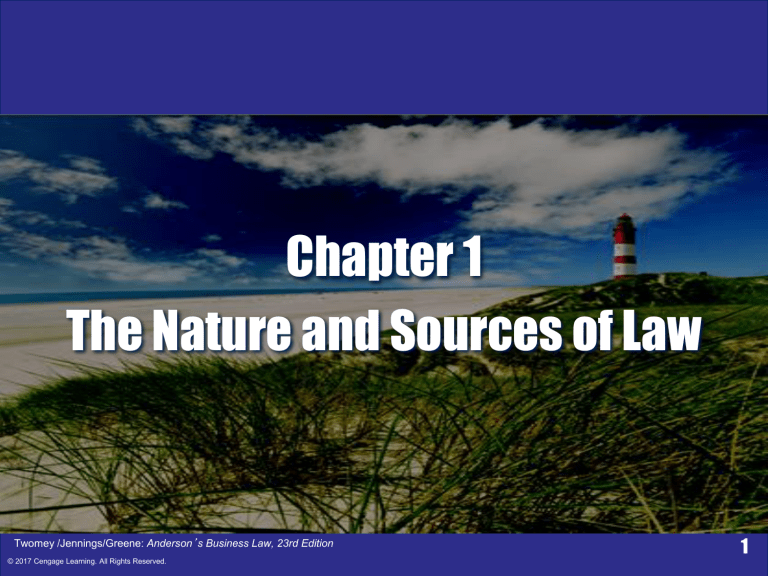
Chapter 1
The Nature and Sources of Law
Twomey /Jennings/Greene: Anderson’s Business Law, 23rd Edition
© 2017 Cengage Learning. All Rights Reserved.
1
LEARNING OUTCOMES
1 Discuss the nature of law and legal rights
2 List the sources of law
3 Describe the classifications of law
Twomey /Jennings/Greene: Anderson’s Business Law, 23rd Edition
© 2017 Cengage Learning. All Rights Reserved.
2
1-1 Nature of Law and Legal Rights
1-1a Legal Rights:
– Legal capacity to require another person to do
or not do an act
– Our rights flow from the U.S. Constitution,
state constitutions, federal and state statutes,
local laws
– Duties and Rights coexist; no right exists
without a corresponding duty
Twomey /Jennings/Greene: Anderson’s Business Law, 23rd Edition
© 2017 Cengage Learning. All Rights Reserved.
3
1-1 Nature of Law and Legal Rights
1-1b Individual Rights:
–
Rights given by the U.S. Constitution (freedom of
speech, due process, right to vote, etc.)
1-1c The Right of Privacy:
–
–
Right to be secure against unreasonable searches
and seizures (Riley v. California, the police cannot
search a smart phone without a warrant)
Includes right to protection against intrusion by
others (Roe v. Wade)
Twomey /Jennings/Greene: Anderson’s Business Law, 23rd Edition
© 2017 Cengage Learning. All Rights Reserved.
4
1-1 Nature of Law and Legal Rights
1-1d Privacy and Technology:
– Technology has changed the way we interact
with each other and allows easier intrusion
into another’s privacy
– Courts and Congress have said that right to
privacy also exists in electronic form and the
Internet
Twomey /Jennings/Greene: Anderson’s Business Law, 23rd Edition
© 2017 Cengage Learning. All Rights Reserved.
5
1-2 Sources of Law
Layers of law which provide the framework for personal
rights and duties:
– 1-2a Constitutional Law
– 1-2b Statutory Law
– 1-2c
Administrative Law
– 1-2d Private Law
– 1-2e Case Law, Statutory Interpretation, and
Precedent
– 1-2f
Treaties and Executive Orders
– 1-2g Uniform State Laws
Twomey /Jennings/Greene: Anderson’s Business Law, 23rd Edition
© 2017 Cengage Learning. All Rights Reserved.
6
1-2 Sources of Law
Private Law
Case Law
Rules and regulations parties agree to as
part of their contractual relationship.
Laws made by decisions of a court;
Clarifies the meaning of statutes and
creates precedents. Many times courts
apply common law.
Treaties and Executive Orders
Treaties made by the United States and
executive orders of the president of the
United States or other public officials.
Uniform State Laws
Statutes drafted by the National
Conference of Commissioners for
adoption by the states. Best example is
the Uniform Commercial Code (UCC).
Twomey /Jennings/Greene: Anderson’s Business Law, 23rd Edition
© 2017 Cengage Learning. All Rights Reserved.
7
1-3 Classifications of Law
1-3a Substantive Law vs. Procedural Law
– Substantive law creates, defines, and regulates
rights and liabilities
– Procedural law specifies how rights and liabilities
are enforced
Twomey /Jennings/Greene: Anderson’s Business Law, 23rd Edition
© 2017 Cengage Learning. All Rights Reserved.
8
1-3 Classifications of Law
1-3b Criminal Law vs. Civil Law
– Criminal laws define wrongs against society
– Civil laws define the rights of one person
against another
1-3c Law vs. Equity
– Equity provides justice when the law does not
offer an adequate remedy or the application
of the law would be terribly unfair
Twomey /Jennings/Greene: Anderson’s Business Law, 23rd Edition
© 2017 Cengage Learning. All Rights Reserved.
9
